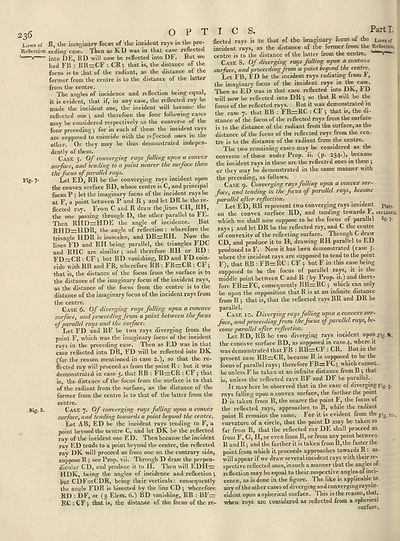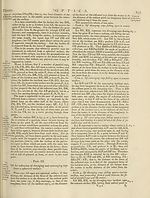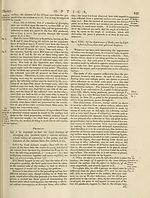Encyclopaedia Britannica > Volume 15, NIC-PAR
(256) Page 236
Download files
Complete book:
Individual page:
Thumbnail gallery: Grid view | List view

236 OPT
Laws of R, the imaginary focus of the incident rays in the pre-
lleflectjon. ceding case. Then as was in that case reflected
' v int0 i>E, RD will now be reflected into DF. But we
had FB : RB=:CF : CR •, that is, the distance of the
focus is to Lbat of the radiant, as the distance ot the
former from the centre is to the distance of the latter
from the centre.
The angles of incidence and reflection being equal,
it is evident, that if, in any case, the reflected ray be
made the incident one, the incident will become the
reflected one •, and therefore the four following cases
may be considered respectively as the converse ot the
four preceding j for m each of them the incident lays
are supposed to coincide with the reflected ones in the
other. Or they may be thus demonstrated indepen¬
dently of them.
Case 5. Of converging rays falling upon a convex
surface, and tending to a point nearer the surface than
the focus of parallel rays.
Fig- 7- Ret ED, RB be the converging rays incident upon
the convex surface BD, whose centre is C, and principal
focus P *, let the imaginary focus of the incident rays be
at F, a point between P and B j and let DR be the re¬
flected ray. From C and R draw thejines CH, RH,
the one passing through D, the other parallel to IE.
Then RHD=HDE the angle of incidence. But
RHD=HDR, the angle of reflection : wherefore the
triangle HDR is isosceles, and DR=rRH. Now the
lines FD and RH being parallel, the triangles FDC
and RHC are similar } and therefore RH or RD :
FDnCR : CF *, but BD vanishing, RD and FD coin¬
cide with RB and FB, wherefore RB : FB=CR : CF j
that is, the distance of the focus from the surface is to
the distance of the imaginary focus of the incident rays,
as the distance of the focus from the centre is to the
distance of the imaginary focus of the incident rays from
the centre.
Case 6. Of diverging rays falling upon a concave
surface, and proceeding from a point between the focus
of parallel rays and the surface.
Let FD and BF be two rays diverging from the
point F, which was the imaginary focus of the incident
rays in the preceding case. Then as ED was in that
case reflected into DR, FD will be reflected into DK
(for the reason mentioned in case 2.), so that the re¬
flected ray will proceed as from the point R : but it was
demonstrated in case 5. that RB : iBrrCR : CF j that
is, the distance of the focus from the surface is to that
of the radiant from the surface, as the distance of the
former from the centre is to that of the latter from the
centre.
Fig. 8. Case 7. Of converging rays falling upon a convex
surface, and tending towards a point beyond the centre.
Let AB, ED be the incident rays tending to F, a
point beyond the centre C, and let DK be the reflected
ray of the incident one ED. Then because the incident
ray ED tends to a point beyond the centre, the reflected
ray DK will proceed as from one on the contrary side,
suppose R see Prop. vii. Through D draw the perpen¬
dicular CD, and produce it to H. Then will EDH-=
HDK, being the angles of incidence and reflection \
but CDF=CDR, being their verticals : consequently
the angle FDR is bisected by the line CD wherefore
RD : DF, or (3 Elem. 6.) BD vanishing, RB : BFrr
RC : CF j that is, the distance of the focus of the re-
I CS. Parti.
fleeted rays is to that of the imaginary focus of the Laws of
incident rays, as the distance of the former from the Reflection,
centre is to the distance ot the latter from the centre. ' 1
Case 8. Of diverging rays fatting upon a concave
surface, and proceeding from a point beyond the centre.
Let FB, ED be the incident rays radiating from F,
the imaginary focus of the incident rays in the case.
Then as ED was in that case reflected into DK, FD
will now he reflected into DR 5 so that R will be the
focus of the reflected rays. But it was demonstrated m
the case 7. that RB : i B=:RC : Cl* j that is, the di¬
stance of the focus of the reflected rays from the surface
is to the distance of the radiant from the surface, as the
distance of the focus of the reflected rays from the cen¬
tre is to the distance of the radiant from the centre.
The two remaining cases may be considered as the
converse of those underProp. ii. (p. 234*)» ^ecause
the incident rays in these are the reflected ones in them j
or they may be demonstrated in the same manner with
the preceding, as follows.
Case 9. Converging rays falling upon a convex sur¬
face, and tending to the focus of parallel rays, become
parallel after reflection.
Let ED, RB represent two converging rays incident p]ate
on the convex surface BD, and tending towards F, ccclxxxu.
which we shall now suppose to be the focus of parallel 7*
rays and let DR be the reflected ray, and C the centre
of convexity of the reflecting surface. Through C draw
CD, and produce it to H, drawing RH parallel to ED
produced to F. Now it has been demonstrated (case y.
where the incident rays are supposed to tend to the point
F), that RB : EB=RC 1 CF j but F in tins case being
supposed to be the focus of parallel rays, it is the
middle point between C and B (by Prop, ii.) and there.-
fore FB = FC, consequently RB=RC 5 which can only
be upon the supposition that R is at an infinite distance
from B j that is> that the reflected rays BR and DR be
parallel.
Case 10. Diverging rays falling upon a concave sur¬
face, and proceeding from the focus oj parallel rays, be¬
come parallel after refection.
Let RD, RB be two diverging rays incident upon .pig. fc-
the concave surface BD, as supposed in case 4- where it
was demonstrated that FB : RBcrrCl* : CR. But in the
present ease RB~CR, because R is supposed to be the
focus of parallel rays 5 therefore 1 B=FC j which cannot-,
be unless F be taken at an infinite distance from B ; that,
is, unless the reflected rays BJ and DF he parallel..
It may here be observed that in the case of diverging Fig. 5.
rays falling upon a.convex surface, the farther the point
D is taken from B, the nearer the point F, the focus of
the reflected rays, approaches to B, while the radiant
point R remains’the same. For-it is evident from theF:g IC..
curvature of a circle, that the point D may be taken so
far from B, that the reflected ray DE shall proceed as
from F, G, H, or even from B, or from any point between
B and R 5 and the farther it is taken from B,the faster the
point from which it proceeds approaches towards R : as
will appear if we draw several incident rays with their re¬
spective reflected ones,insuch a manner that the angles of
reflection may be equal to their respective angles of inci-
cence, as is done in the figure. The like is applicable to
any of the other cases of diverging and convergingraysin-
cident upon a spherical surface. This is the reason, that,
when rays are considered as reflected from a spherical
surface,.
Laws of R, the imaginary focus of the incident rays in the pre-
lleflectjon. ceding case. Then as was in that case reflected
' v int0 i>E, RD will now be reflected into DF. But we
had FB : RB=:CF : CR •, that is, the distance of the
focus is to Lbat of the radiant, as the distance ot the
former from the centre is to the distance of the latter
from the centre.
The angles of incidence and reflection being equal,
it is evident, that if, in any case, the reflected ray be
made the incident one, the incident will become the
reflected one •, and therefore the four following cases
may be considered respectively as the converse ot the
four preceding j for m each of them the incident lays
are supposed to coincide with the reflected ones in the
other. Or they may be thus demonstrated indepen¬
dently of them.
Case 5. Of converging rays falling upon a convex
surface, and tending to a point nearer the surface than
the focus of parallel rays.
Fig- 7- Ret ED, RB be the converging rays incident upon
the convex surface BD, whose centre is C, and principal
focus P *, let the imaginary focus of the incident rays be
at F, a point between P and B j and let DR be the re¬
flected ray. From C and R draw thejines CH, RH,
the one passing through D, the other parallel to IE.
Then RHD=HDE the angle of incidence. But
RHD=HDR, the angle of reflection : wherefore the
triangle HDR is isosceles, and DR=rRH. Now the
lines FD and RH being parallel, the triangles FDC
and RHC are similar } and therefore RH or RD :
FDnCR : CF *, but BD vanishing, RD and FD coin¬
cide with RB and FB, wherefore RB : FB=CR : CF j
that is, the distance of the focus from the surface is to
the distance of the imaginary focus of the incident rays,
as the distance of the focus from the centre is to the
distance of the imaginary focus of the incident rays from
the centre.
Case 6. Of diverging rays falling upon a concave
surface, and proceeding from a point between the focus
of parallel rays and the surface.
Let FD and BF be two rays diverging from the
point F, which was the imaginary focus of the incident
rays in the preceding case. Then as ED was in that
case reflected into DR, FD will be reflected into DK
(for the reason mentioned in case 2.), so that the re¬
flected ray will proceed as from the point R : but it was
demonstrated in case 5. that RB : iBrrCR : CF j that
is, the distance of the focus from the surface is to that
of the radiant from the surface, as the distance of the
former from the centre is to that of the latter from the
centre.
Fig. 8. Case 7. Of converging rays falling upon a convex
surface, and tending towards a point beyond the centre.
Let AB, ED be the incident rays tending to F, a
point beyond the centre C, and let DK be the reflected
ray of the incident one ED. Then because the incident
ray ED tends to a point beyond the centre, the reflected
ray DK will proceed as from one on the contrary side,
suppose R see Prop. vii. Through D draw the perpen¬
dicular CD, and produce it to H. Then will EDH-=
HDK, being the angles of incidence and reflection \
but CDF=CDR, being their verticals : consequently
the angle FDR is bisected by the line CD wherefore
RD : DF, or (3 Elem. 6.) BD vanishing, RB : BFrr
RC : CF j that is, the distance of the focus of the re-
I CS. Parti.
fleeted rays is to that of the imaginary focus of the Laws of
incident rays, as the distance of the former from the Reflection,
centre is to the distance ot the latter from the centre. ' 1
Case 8. Of diverging rays fatting upon a concave
surface, and proceeding from a point beyond the centre.
Let FB, ED be the incident rays radiating from F,
the imaginary focus of the incident rays in the case.
Then as ED was in that case reflected into DK, FD
will now he reflected into DR 5 so that R will be the
focus of the reflected rays. But it was demonstrated m
the case 7. that RB : i B=:RC : Cl* j that is, the di¬
stance of the focus of the reflected rays from the surface
is to the distance of the radiant from the surface, as the
distance of the focus of the reflected rays from the cen¬
tre is to the distance of the radiant from the centre.
The two remaining cases may be considered as the
converse of those underProp. ii. (p. 234*)» ^ecause
the incident rays in these are the reflected ones in them j
or they may be demonstrated in the same manner with
the preceding, as follows.
Case 9. Converging rays falling upon a convex sur¬
face, and tending to the focus of parallel rays, become
parallel after reflection.
Let ED, RB represent two converging rays incident p]ate
on the convex surface BD, and tending towards F, ccclxxxu.
which we shall now suppose to be the focus of parallel 7*
rays and let DR be the reflected ray, and C the centre
of convexity of the reflecting surface. Through C draw
CD, and produce it to H, drawing RH parallel to ED
produced to F. Now it has been demonstrated (case y.
where the incident rays are supposed to tend to the point
F), that RB : EB=RC 1 CF j but F in tins case being
supposed to be the focus of parallel rays, it is the
middle point between C and B (by Prop, ii.) and there.-
fore FB = FC, consequently RB=RC 5 which can only
be upon the supposition that R is at an infinite distance
from B j that is> that the reflected rays BR and DR be
parallel.
Case 10. Diverging rays falling upon a concave sur¬
face, and proceeding from the focus oj parallel rays, be¬
come parallel after refection.
Let RD, RB be two diverging rays incident upon .pig. fc-
the concave surface BD, as supposed in case 4- where it
was demonstrated that FB : RBcrrCl* : CR. But in the
present ease RB~CR, because R is supposed to be the
focus of parallel rays 5 therefore 1 B=FC j which cannot-,
be unless F be taken at an infinite distance from B ; that,
is, unless the reflected rays BJ and DF he parallel..
It may here be observed that in the case of diverging Fig. 5.
rays falling upon a.convex surface, the farther the point
D is taken from B, the nearer the point F, the focus of
the reflected rays, approaches to B, while the radiant
point R remains’the same. For-it is evident from theF:g IC..
curvature of a circle, that the point D may be taken so
far from B, that the reflected ray DE shall proceed as
from F, G, H, or even from B, or from any point between
B and R 5 and the farther it is taken from B,the faster the
point from which it proceeds approaches towards R : as
will appear if we draw several incident rays with their re¬
spective reflected ones,insuch a manner that the angles of
reflection may be equal to their respective angles of inci-
cence, as is done in the figure. The like is applicable to
any of the other cases of diverging and convergingraysin-
cident upon a spherical surface. This is the reason, that,
when rays are considered as reflected from a spherical
surface,.
Set display mode to:
![]() Universal Viewer |
Universal Viewer | ![]() Mirador |
Large image | Transcription
Mirador |
Large image | Transcription
Images and transcriptions on this page, including medium image downloads, may be used under the Creative Commons Attribution 4.0 International Licence unless otherwise stated. ![]()
| Encyclopaedia Britannica > Encyclopaedia Britannica > Volume 15, NIC-PAR > (256) Page 236 |
|---|
| Permanent URL | https://digital.nls.uk/192585026 |
|---|
| Attribution and copyright: |
|
|---|
| Shelfmark | EB.11 |
|---|---|
| Description | Ten editions of 'Encyclopaedia Britannica', issued from 1768-1903, in 231 volumes. Originally issued in 100 weekly parts (3 volumes) between 1768 and 1771 by publishers: Colin Macfarquhar and Andrew Bell (Edinburgh); editor: William Smellie: engraver: Andrew Bell. Expanded editions in the 19th century featured more volumes and contributions from leading experts in their fields. Managed and published in Edinburgh up to the 9th edition (25 volumes, from 1875-1889); the 10th edition (1902-1903) re-issued the 9th edition, with 11 supplementary volumes. |
|---|---|
| Additional NLS resources: |
|

